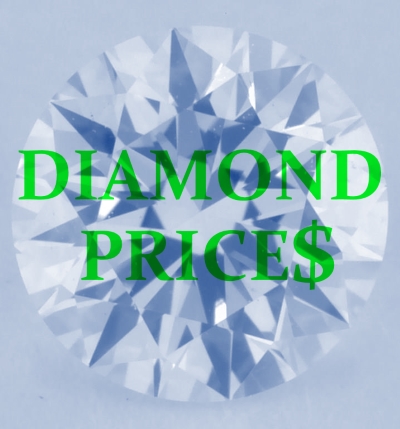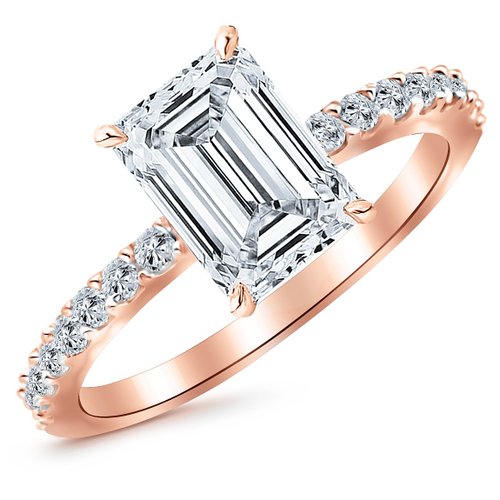What Are Diamond Chips?
Diamond chips, as their name suggests, are small pieces that were broken off a bigger stone. They are not polished or shaped in any particular form.
A diamond chip is a piece of diamond that is not faceted. Diamond chips are usually small (less than 0.2 carats in weight) and are often used as accent stones surrounding a bigger center diamond. Since chips are not polished, their surface is not smooth but is rough to the touch.

People use the term “diamond chips” to refer to the small stones surrounding a center diamond.
These chips are not really symmetrical, and they can most often be seen in vintage jewelry, where they are used as accent stones.
Real Diamond Chips: Rarely Used Today
Most people use the term “diamond chips” to refer to the small stones surrounding a center diamond in a piece of jewelry.
However, in most cases, these stones are not really chips. In reality, diamond chips are rarely used in jewelry these days.
In the past, when cutting and polishing technology was not as advanced as it is today, it was very hard to shape a small diamond and cut facets in it.
Nowadays, this is not such a big problem, and the stones customers often call “chips” are actually diamonds that have been cut and polished; they are also known as “single-cut diamonds.”
The Value of Diamond Chips
Diamond chips are much cheaper per carat compared with diamonds that are cut and polished. The reason for this is not only the small size of chips – they are also cheaper than cut and polished diamonds of the same size.
Here you can see offers for diamonds chips and their prices.
Diamond chips have low value manly because they are not faceted.
As a result, these stones do not bend and reflect light the same way faceted diamonds do.
Because of this, chips have much lower brilliance than stones cut with facets.
The lack of polish also contributes to the low sparkle of diamond chips – the roughness of their surface further impedes the reflection of light.
Evaluating Diamond Chips
If you happen to be looking at a piece of jewelry with diamond chips, here’s what you should know about the characteristics that determine their price:
Color of Diamond Chips
As with all diamonds, how colorless a diamond chip is affects its value: The more visible yellowish color you can see in a stone, the less valuable it is.
It is also important for diamond chips to be uniform in terms of color when a lot of them are set together in a piece of jewelry: You don’t want a patchwork of stones with visible darker and lighter clusters.
Also, if there is a center stone in the setting, the diamond chips surrounding it should match its color.
Clarity and Diamond Chips
This characteristic affects the value of chips in much the same way as it does that of faceted diamonds: The fewer inclusions inside a stone, the more valuable it is.
However, for diamond chips, clarity is not as important as color because they are often so small that individual flaws are usually not visible from a normal viewing distance.
However, jewelry with diamond chips that have prominent flaws should be discounted.
Cut of Diamond Chips
As already mentioned, this characteristic is not really applicable to diamond chips as they are not cut and faceted. If anything, the lack of definite cut makes chips much less valuable than faceted stones of similar size.
Carat and Diamond Chips
In general, bigger diamonds are more expensive per unit of weight than smaller ones.
The reason for this is rarity: Larger diamonds are simply found much less often.
All else being equal, the same principle holds for chips of different sizes: Bigger ones cost more per carat than smaller diamond chips.
Diamond Chips vs. Single-Cut Diamonds
Whereas chips don’t really have a symmetrical shape, single-cut diamonds are round and faceted.
Diamond chips were used in jewelry in the past, when cutting technologies were not precise enough to allow jewelers to cut small diamond pieces into faceted stones. Nowadays, single-cut diamonds are used instead of diamond chips.
Single-cut diamonds are small stones (usually less than 0.2 carats) that are faceted, but the number of facets they come with is smaller than that of bigger diamonds.
For example, single-cut diamonds tend to have 16-18 facets, whereas normal-size round diamonds have 57 or 58 facets (these stones are also called “full-cut” diamonds).
Single-cut diamonds are also called “melee diamonds,” and many jewelers also refer to them as diamond accents (or accent diamonds). They are used to complement the center stone in some types of settings (as an example, check out these halo settings, in which the central diamond is surrounded by smaller accents)
It is worth noting that single-cut diamonds can actually be referred to as chips, so when this term is used, you should clarify whether the diamonds are uncut or are actually faceted.
Why Single-Cut Diamonds Are Better Than Chips
So, what difference does it make if single-cut accent stones are faceted while diamond chips are not?
Well, as a result of being cut in certain proportions, single-cut diamonds can reflect light in a way that allows them to exhibit brilliance and sparkle.
Chips, on the other hand, do not bend light as faceted stones do, and as a result, diamond chips do not have the same brilliance. That’s why a ring decorated with single-cut diamond accents will have more sparkle than one with chips.
Another plus for jewelry made with single-cut stones is that their uniform shape gives the piece a more even appearance than that of jewelry made with chips.
Price of Diamond Chips
Since real diamond chips are rarely sold today, the prices you will find quoted for chips will most likely pertain to single-cut diamonds.
If the “chips” sold are referred to as “melee,” “single cuts,” “diamond accents” or something similar, then they are actually single-cut stones.
Just as the price of regular diamonds rises with their carat, so does the value of diamond chips.
A melee diamond of 0.01-0.02 carats (or 1-2 points) can cost between $300 and $700 per carat depending on the stone’s color and clarity as well as the seller (wholesale prices are lower than retail ones).
A 0.10-carat melee can cost more than $1,000 (again, retail prices are higher, and stones with better clarity and color sell for more).
Keep in mind that these prices can vary significantly over time.
Related: If you are interested in the prices of full-cut loose diamonds, you can use this loose diamond search engine for your research.
Should You Buy Jewelry with Diamond Chips?
Although a lot of stones called chips these days are simply melee diamonds, some pieces of jewelry are made with real diamond chips. This is why you should look closely at any piece with small stones to check whether they are faceted or not.
In general, jewelry with diamond chips should be cheaper than that made with melee diamonds.
However, you should ask yourself whether it is worth it for you to buy such a piece. For one thing, because they are not faceted, chips don’t have much brilliance.
If you are trying to decide whether to buy a ring with chips, for example, compare it with one made with real single-cut stones. You might find that the additional sparkle of melee stones is worth paying a little more and getting a ring with faceted diamonds.
In sum, if brilliance is important to you, pick jewelry with faceted diamond accents.
Looking to sell your engagement ring or other diamond jewelry? Check out Worthy, which is an online jewelry auction platform — you can mail in your jewelry and let Worthy organize the sale for you, sending you the money after the piece is sold.
Where to Buy Diamond Jewelry?
We recommend James Allen (read review) because you can take a 360-degree look at any stone before buying it.
Blue Nile is another reputable diamond retailer we recommend.















